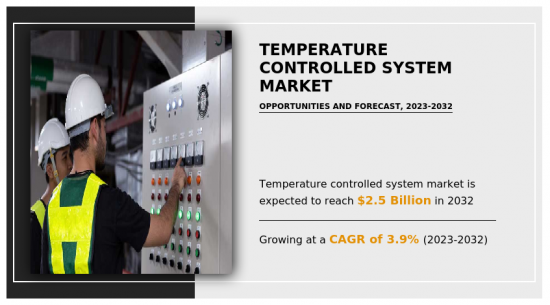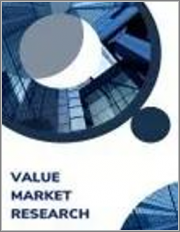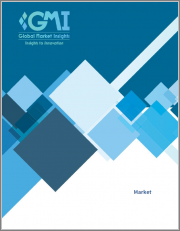
|
시장보고서
상품코드
1446918
온도 제어 시스템 시장 : 유형별, 용도별, 최종사용자별 - 세계 기회 분석과 산업 예측(2023-2032년)Temperature Controlled System Market By Type, By Application, By End User : Global Opportunity Analysis and Industry Forecast, 2023-2032 |
||||||
세계의 온도 제어 시스템 시장은 2023-2032년 CAGR 3.9%로 2022년 17억 5,800만 달러에서 성장하며, 2032년에는 25억 3,520만 달러에 달할 것으로 예측되고 있습니다.

온도 제어 시스템(TCS)은 정해진 영역 내에서 또는 특정 처리 중에 지정된 온도를 조절하고 유지하도록 설계된 첨단 컴포넌트 및 기술 네트워크로 구성됩니다. 이러한 시스템은 정확한 온도 범위를 유지하고 공정, 재료 또는 생물체에 최적의 조건을 조성하기 위해 많은 산업 및 용도에서 활용되고 있습니다. 온도 제어 시스템의 주요 목적은 외부 요인이나 변화의 영향을 최소화하면서 정확하고 신뢰할 수 있으며 반응성이 높은 온도 제어를 제공하는 것입니다. 온도 제어는 화학 제조, 식품 가공, 반도체 제조 등 많은 산업 공정에서 매우 중요합니다.
온도 제어 시스템은 낭비를 줄이고 절차를 간소화하여 작업 효율성을 높입니다. 이러한 시스템은 부패하기 쉬운 상품을 장거리로 운송하는 물류 및 운송과 같은 산업에서 부패를 최소화하고 제품의 신선도를 유지하는 데 중요한 역할을 합니다. 이를 통해 공급망을 최적화할 뿐만 아니라, 제품 열화 및 손상으로 인한 운영 비용도 절감할 수 있습니다. 온도 제어 시스템의 가장 큰 장점 중 하나는 제품의 무결성을 보호하는 것입니다. 정밀한 온도 제어는 의약품의 효능을 유지하든, 신선식품의 유통기한을 연장하든, 제품이 완벽한 상태로 고객에게 전달될 수 있도록 보장합니다. 온도 관리 시스템은 전체 공급망에 실시간으로 데이터를 제공하여 기업이 비효율성을 파악하고 운영을 최적화할 수 있도록 도와줍니다.
초기 투자 비용 외에도 온도 관리 시스템의 운영 비용은 상당합니다. 정확한 온도 설정을 유지하기 위해서는 지속적인 에너지 투입이 필요하며, 이는 높은 유틸리티 비용을 초래합니다. 이러한 장비는 많은 에너지를 소비하기 때문에 환경에 대한 우려가 커지는 동시에 운영 비용도 증가합니다. 온도 제어 작업장의 에너지 효율을 높이고 운영 비용을 절감할 수 있는 방법을 찾는 것은 영원한 과제입니다. 온도 제어 시스템은 적절한 작동과 정확성을 보장하기 위해 잦은 유지보수가 필요합니다. 여기에는 센서 점검 및 교정, HVAC(난방, 환기, 공조) 시스템 청소, 결함 문제 해결 등이 포함됩니다. 유지보수 작업에는 전문 지식과 자격을 갖춘 인력이 필요할 수 있으며, 이는 총 운영 비용을 증가시킬 수 있습니다.
E-Commerce와 세계 무역의 확대로 인해 신뢰할 수 있고 효율적인 콜드체인 물류에 대한 수요가 증가하고 있습니다. 신선식품이나 의약품과 같은 부패하기 쉬운 품목은 제조업체에서 최종사용자까지 일관된 온도 관리가 필요합니다. 온도 제어 운송 솔루션을 전문으로 하는 기업은 이 확장되는 분야의 최전선에 있으며, 발전과 전문화의 가능성을 창출하고 있습니다. 과학자와 엔지니어들은 온도 제어 시스템의 효율성과 신뢰성을 높이기 위해 끊임없이 새로운 재료와 기술을 찾고 있습니다. 정교한 단열재에서 최첨단 냉동 기술에 이르기까지 이 분야는 끊임없이 발전하고 있습니다.
COVID-19 팬데믹의 주요 영향 중 하나는 의약품 냉장 창고에 대한 수요 증가였습니다. 백신의 유통과 보관이 매우 중요하기 때문에 제약회사와 물류업체들은 백신을 초저온으로 안전하게 운송하고 보관하는 데 큰 어려움을 겪었습니다. 이러한 예상치 못한 수요 증가는 이 분야의 콜드체인 인프라에 부담을 주었고, 사업자들은 보관 시설의 확장 및 강화에 투자해야 했으며, COVID-19 백신 접종에 대한 규제 강화로 인해 온도 관리 시스템내 실시간 모니터링 및 추적의 필요성이 대두되었습니다. 온도 관리 시스템내 실시간 모니터링 및 추적의 필요성도 부각되었고, 기업은 콜드체인 무결성을 보장하기 위해 새로운 기술을 도입해야 했습니다. 또한 이번 팬데믹은 온도 관리 시스템에서 유연성과 민첩성의 중요성을 강조했습니다.
이해관계자 주요 이점
- 이 보고서는 2022-2032년 온도 제어 시스템 시장 분석 시장 부문, 현재 동향, 추정 및 동향 분석, 역학을 정량적으로 분석하여 일반적인 온도 제어 시스템 시장 기회를 식별합니다.
- 시장 성장 촉진요인, 시장 성장 억제요인, 시장 기회와 관련된 정보와 함께 시장 조사를 제공합니다.
- Porter's Five Forces 분석은 이해 관계자가 이익 중심의 비즈니스 결정을 내리고 공급자와 구매자의 네트워크를 강화할 수 있도록 구매자와 공급자의 잠재력을 밝힙니다.
- 온도 제어 시스템 시장의 세분화를 자세히 분석하여 시장 기회를 파악할 수 있습니다.
- 각 지역의 주요 국가는 세계 시장에 대한 매출 기여도에 따라 매핑되어 있습니다.
- 시장 기업의 포지셔닝은 벤치마킹을 용이하게 하고 시장 기업의 현재 위치를 명확하게 이해할 수 있습니다.
- 이 보고서에는 지역별 및 세계 온도 제어 시스템 시장 동향, 주요 기업, 시장 부문, 용도, 시장 성장 전략에 대한 분석이 포함되어 있습니다.
이 보고서에서 가능한 보고서 커스터마이징
- 제품에 포함된 원재료 분석(%별)
- 제조 능력
- 제품 벤치마킹/제품 사양 및 용도
- 시장 진출 전략
- 통증 포인트 분석
- 규제 가이드라인
- 전략적 추천
- 고객의 관심사에 특화된 추가 기업 개요
- 국가별 또는 지역별 추가 분석 - 시장 규모 및 예측
- 크리스크로스 부문 분석 - 시장 규모 및 예측
- 기업 개요 확장 리스트
- 과거 시장 데이터
- 주요 기업의 세부 정보(위치, 연락처, 공급업체/벤더 네트워크 등 포함, 엑셀 형식)
- 세계/지역/국가별 기업의 시장 점유율 분석
- SWOT 분석
목차
제1장 서론
제2장 주요 요약
제3장 시장 개요
- 시장의 정의와 범위
- 주요 조사 결과
- 영향요인
- 주요 투자 기회
- Porter's Five Forces 분석
- 시장 역학
- 촉진요인
- 억제요인
- 기회
- 시장 점유율 분석
- 밸류체인 분석
- 규제 가이드라인
- 주요 규제 분석
- 특허 상황
제4장 온도 제어 시스템 시장 : 유형별
- 개요
- 오픈 루프
- 클로즈드 루프 제어
제5장 온도 제어 시스템 시장 : 용도별
- 개요
- 공조
- 급탕기
- 냉장고
- 기타
제6장 온도 제어 시스템 시장 : 최종사용자별
- 개요
- 산업용 온도 제어 시스템
- 가정용 온도 제어 시스템
- 기타
제7장 온도 제어 시스템 시장 : 지역별
- 개요
- 북미
- 미국
- 캐나다
- 멕시코
- 유럽
- 독일
- 영국
- 프랑스
- 스위스
- 이탈리아
- 기타
- 아시아태평양
- 중국
- 일본
- 인도
- 한국
- 호주
- 기타
- 라틴아메리카·중동 및 아프리카
- 브라질
- 사우디아라비아
- UAE
- 남아프리카공화국
- 기타
제8장 경쟁 상황
- 서론
- 주요 성공 전략
- 주요 10사의 제품 매핑
- 경쟁 대시보드
- 경쟁 히트맵
- 주요 기업의 포지셔닝, 2022년
제9장 기업 개요
- Carrier Global Corporation
- Daikin Industries, Ltd.
- Johnson Controls International PLC
- Siemens AG
- Emerson Electric Co.
- Honeywell International Inc.
- Mitsubishi Electric Corporation
- Schneider Electric SE
- Ingersoll Rand
- LG Electronics Inc.
- Delta Controls Inc.
The global temperature controlled system market is anticipated to reach $2,535.2 million by 2032, growing from $1,758 million in 2022 at a CAGR of 3.9% from 2023 to 2032.

A Temperature Controlled System (TCS) is a sophisticated network of components and technology designed to regulate and maintain a specified temperature inside a defined region or during a specific procedure. These systems are utilized in a number of industries and applications to maintain precise temperature ranges, fostering optimal conditions for processes, materials, or organisms. A temperature control system's major purpose is to provide accurate, dependable, and responsive temperature management while reducing the impact of external causes and changes. Temperature control is critical in many industrial processes, including chemical manufacturing, food processing, and semiconductor manufacturing.
Temperature-controlled systems increase operational efficiency by reducing wastage and streamlining procedures. These systems play a vital role in minimizing spoilage and maintaining product freshness in industries such as logistics and transportation, where perishable commodities are moved over great distances. This not only optimizes the supply chain but also reduces operational costs associated with deteriorating or damaged products. One of the most significant advantages of temperature-controlled systems is the protection of product integrity. Precision temperature control ensures that things reach clients in perfect condition, whether it is to maintain the efficacy of medications or to extend the shelf life of perishable commodities. Temperature-controlled systems help businesses identify inefficiencies and optimize operations by delivering real-time data across the whole supply chain.
Apart from the initial investment, the operating costs of temperature-controlled systems can be substantial. Maintaining accurate temperature settings needs continual energy input, which contributes to high utility bills. These devices' energy-intensive nature raises environmental concerns while also increasing operational expenses. Finding methods to increase energy efficiency and reduce operational costs in temperature-controlled workplaces is a never-ending challenge. Temperature-controlled systems require frequent maintenance to ensure appropriate operation and accuracy. The work includes inspecting and calibrating sensors, cleaning HVAC (heating, ventilation, and air conditioning) systems, and troubleshooting any faults. Maintenance activities may need specialized expertise and qualified personnel, increasing total operational costs.
The growth of e-commerce and worldwide trade has led to an increase in demand for dependable and efficient cold chain logistics. Perishable items, such as fresh food and medications, require consistent temperature control from manufacturer to end-user. Companies that specialize in temperature-controlled transport solutions are at the forefront of this expanding sector, generating potential for development and specialization. Scientists and engineers are always looking for new materials and technologies to increase the efficiency and dependability of temperature control systems. The sector is constantly improving, from sophisticated insulating materials to cutting-edge refrigeration technology.
One of the primary impacts of the COVID-19 pandemic was an increase in demand for pharmaceutical cold storage. Because of the crucial need for vaccine distribution and storage, pharmaceutical companies and logistics providers faced significant challenges in ensuring the safe transportation and storage of vaccines at ultra-low temperatures. This unanticipated increase in demand led to a strain on the sector's cold chain infrastructure, prompting the business to invest in expanding and enhancing storage facilities. The urgency to regulate COVID-19 vaccinations also highlighted the need of real-time monitoring and tracking inside temperature-controlled systems, prompting enterprises to install new technologies to ensure the integrity of the cold chain. The pandemic also highlighted the significance of flexibility and agility in temperature-controlled systems.
The key players profiled in this report include Carrier Global Corporation, Daikin Industries, Ltd., Johnson Controls, International plc, Siemens AG, Emerson Electric Co., Honeywell International Inc., Mitsubishi Electric Corporation, Schneider Electric SE, Ingersoll Rand, and LG Electronics Inc. The market players are continuously striving to achieve a dominant position in this competitive market using strategies such as innovation and technological advancements and cost leadership.
Key Benefits For Stakeholders
- This report provides a quantitative analysis of the market segments, current trends, estimations, and dynamics of the temperature controlled system market analysis from 2022 to 2032 to identify the prevailing temperature controlled system market opportunities.
- The market research is offered along with information related to key drivers, restraints, and opportunities.
- Porter's five forces analysis highlights the potency of buyers and suppliers to enable stakeholders make profit-oriented business decisions and strengthen their supplier-buyer network.
- In-depth analysis of the temperature controlled system market segmentation assists to determine the prevailing market opportunities.
- Major countries in each region are mapped according to their revenue contribution to the global market.
- Market player positioning facilitates benchmarking and provides a clear understanding of the present position of the market players.
- The report includes the analysis of the regional as well as global temperature controlled system market trends, key players, market segments, application areas, and market growth strategies.
Additional benefits you will get with this purchase are:
- Quarterly Update and* (only available with a corporate license, on listed price)
- 5 additional Company Profile of client Choice pre- or Post-purchase, as a free update.
- Free Upcoming Version on the Purchase of Five and Enterprise User License.
- 16 analyst hours of support* (post-purchase, if you find additional data requirements upon review of the report, you may receive support amounting to 16 analyst hours to solve questions, and post-sale queries)
- 15% Free Customization* (in case the scope or segment of the report does not match your requirements, 15% is equivalent to 3 working days of free work, applicable once)
- Free data Pack on the Five and Enterprise User License. (Excel version of the report)
- Free Updated report if the report is 6-12 months old or older.
- 24-hour priority response*
- Free Industry updates and white papers.
Possible Customization with this report (with additional cost and timeline, please talk to the sales executive to know more)
- Analysis of raw material in a product (by %)
- Manufacturing Capacity
- Product Benchmarking / Product specification and applications
- Go To Market Strategy
- Pain Point Analysis
- Regulatory Guidelines
- Strategic Recommedations
- Additional company profiles with specific to client's interest
- Additional country or region analysis- market size and forecast
- Criss-cross segment analysis- market size and forecast
- Expanded list for Company Profiles
- Historic market data
- Key player details (including location, contact details, supplier/vendor network etc. in excel format)
- Market share analysis of players at global/region/country level
- SWOT Analysis
Key Market Segments
By Type
- Open Loop
- Closed Loop Control
By Application
- Refrigators
- Others
- Air conditioning
- Water Heater
By End User
- Industrial Temperature Controlled System
- Home Temperature Controlled System
- Others
By Region
- North America
- U.S.
- Canada
- Mexico
- Europe
- Germany
- UK
- France
- Switzerland
- Italy
- Rest of Europe
- Asia-Pacific
- China
- Japan
- India
- South Korea
- Australia
- Rest of Asia-Pacific
- LAMEA
- Brazil
- Saudi Arabia
- UAE
- South Africa
- Rest of LAMEA
Key Market Players:
- Carrier Global Corporation
- Daikin Industries, Ltd.
- Johnson Controls International PLC
- Siemens AG
- Emerson Electric Co.
- Honeywell International Inc.
- Mitsubishi Electric Corporation
- Schneider Electric SE
- Ingersoll Rand
- LG Electronics Inc.
- Delta Controls Inc.
TABLE OF CONTENTS
CHAPTER 1: INTRODUCTION
- 1.1. Report description
- 1.2. Key market segments
- 1.3. Key benefits to the stakeholders
- 1.4. Research methodology
- 1.4.1. Primary research
- 1.4.2. Secondary research
- 1.4.3. Analyst tools and models
CHAPTER 2: EXECUTIVE SUMMARY
- 2.1. CXO Perspective
CHAPTER 3: MARKET OVERVIEW
- 3.1. Market definition and scope
- 3.2. Key findings
- 3.2.1. Top impacting factors
- 3.2.2. Top investment pockets
- 3.3. Porter's five forces analysis
- 3.4. Market dynamics
- 3.4.1. Drivers
- 3.4.2. Restraints
- 3.4.3. Opportunities
- 3.5. Market Share Analysis
- 3.6. Value Chain Analysis
- 3.7. Regulatory Guidelines
- 3.8. Key Regulation Analysis
- 3.9. Patent Landscape
CHAPTER 4: TEMPERATURE CONTROLLED SYSTEM MARKET, BY TYPE
- 4.1. Overview
- 4.1.1. Market size and forecast
- 4.2. Open Loop
- 4.2.1. Key market trends, growth factors and opportunities
- 4.2.2. Market size and forecast, by region
- 4.2.3. Market share analysis by country
- 4.3. Closed Loop Control
- 4.3.1. Key market trends, growth factors and opportunities
- 4.3.2. Market size and forecast, by region
- 4.3.3. Market share analysis by country
CHAPTER 5: TEMPERATURE CONTROLLED SYSTEM MARKET, BY APPLICATION
- 5.1. Overview
- 5.1.1. Market size and forecast
- 5.2. Air conditioning
- 5.2.1. Key market trends, growth factors and opportunities
- 5.2.2. Market size and forecast, by region
- 5.2.3. Market share analysis by country
- 5.3. Water Heater
- 5.3.1. Key market trends, growth factors and opportunities
- 5.3.2. Market size and forecast, by region
- 5.3.3. Market share analysis by country
- 5.4. Refrigators
- 5.4.1. Key market trends, growth factors and opportunities
- 5.4.2. Market size and forecast, by region
- 5.4.3. Market share analysis by country
- 5.5. Others
- 5.5.1. Key market trends, growth factors and opportunities
- 5.5.2. Market size and forecast, by region
- 5.5.3. Market share analysis by country
CHAPTER 6: TEMPERATURE CONTROLLED SYSTEM MARKET, BY END USER
- 6.1. Overview
- 6.1.1. Market size and forecast
- 6.2. Industrial Temperature Controlled System
- 6.2.1. Key market trends, growth factors and opportunities
- 6.2.2. Market size and forecast, by region
- 6.2.3. Market share analysis by country
- 6.3. Home Temperature Controlled System
- 6.3.1. Key market trends, growth factors and opportunities
- 6.3.2. Market size and forecast, by region
- 6.3.3. Market share analysis by country
- 6.4. Others
- 6.4.1. Key market trends, growth factors and opportunities
- 6.4.2. Market size and forecast, by region
- 6.4.3. Market share analysis by country
CHAPTER 7: TEMPERATURE CONTROLLED SYSTEM MARKET, BY REGION
- 7.1. Overview
- 7.1.1. Market size and forecast By Region
- 7.2. North America
- 7.2.1. Key market trends, growth factors and opportunities
- 7.2.2. Market size and forecast, by Type
- 7.2.3. Market size and forecast, by Application
- 7.2.4. Market size and forecast, by End User
- 7.2.5. Market size and forecast, by country
- 7.2.5.1. U.S.
- 7.2.5.1.1. Market size and forecast, by Type
- 7.2.5.1.2. Market size and forecast, by Application
- 7.2.5.1.3. Market size and forecast, by End User
- 7.2.5.2. Canada
- 7.2.5.2.1. Market size and forecast, by Type
- 7.2.5.2.2. Market size and forecast, by Application
- 7.2.5.2.3. Market size and forecast, by End User
- 7.2.5.3. Mexico
- 7.2.5.3.1. Market size and forecast, by Type
- 7.2.5.3.2. Market size and forecast, by Application
- 7.2.5.3.3. Market size and forecast, by End User
- 7.3. Europe
- 7.3.1. Key market trends, growth factors and opportunities
- 7.3.2. Market size and forecast, by Type
- 7.3.3. Market size and forecast, by Application
- 7.3.4. Market size and forecast, by End User
- 7.3.5. Market size and forecast, by country
- 7.3.5.1. Germany
- 7.3.5.1.1. Market size and forecast, by Type
- 7.3.5.1.2. Market size and forecast, by Application
- 7.3.5.1.3. Market size and forecast, by End User
- 7.3.5.2. UK
- 7.3.5.2.1. Market size and forecast, by Type
- 7.3.5.2.2. Market size and forecast, by Application
- 7.3.5.2.3. Market size and forecast, by End User
- 7.3.5.3. France
- 7.3.5.3.1. Market size and forecast, by Type
- 7.3.5.3.2. Market size and forecast, by Application
- 7.3.5.3.3. Market size and forecast, by End User
- 7.3.5.4. Switzerland
- 7.3.5.4.1. Market size and forecast, by Type
- 7.3.5.4.2. Market size and forecast, by Application
- 7.3.5.4.3. Market size and forecast, by End User
- 7.3.5.5. Italy
- 7.3.5.5.1. Market size and forecast, by Type
- 7.3.5.5.2. Market size and forecast, by Application
- 7.3.5.5.3. Market size and forecast, by End User
- 7.3.5.6. Rest of Europe
- 7.3.5.6.1. Market size and forecast, by Type
- 7.3.5.6.2. Market size and forecast, by Application
- 7.3.5.6.3. Market size and forecast, by End User
- 7.4. Asia-Pacific
- 7.4.1. Key market trends, growth factors and opportunities
- 7.4.2. Market size and forecast, by Type
- 7.4.3. Market size and forecast, by Application
- 7.4.4. Market size and forecast, by End User
- 7.4.5. Market size and forecast, by country
- 7.4.5.1. China
- 7.4.5.1.1. Market size and forecast, by Type
- 7.4.5.1.2. Market size and forecast, by Application
- 7.4.5.1.3. Market size and forecast, by End User
- 7.4.5.2. Japan
- 7.4.5.2.1. Market size and forecast, by Type
- 7.4.5.2.2. Market size and forecast, by Application
- 7.4.5.2.3. Market size and forecast, by End User
- 7.4.5.3. India
- 7.4.5.3.1. Market size and forecast, by Type
- 7.4.5.3.2. Market size and forecast, by Application
- 7.4.5.3.3. Market size and forecast, by End User
- 7.4.5.4. South Korea
- 7.4.5.4.1. Market size and forecast, by Type
- 7.4.5.4.2. Market size and forecast, by Application
- 7.4.5.4.3. Market size and forecast, by End User
- 7.4.5.5. Australia
- 7.4.5.5.1. Market size and forecast, by Type
- 7.4.5.5.2. Market size and forecast, by Application
- 7.4.5.5.3. Market size and forecast, by End User
- 7.4.5.6. Rest of Asia-Pacific
- 7.4.5.6.1. Market size and forecast, by Type
- 7.4.5.6.2. Market size and forecast, by Application
- 7.4.5.6.3. Market size and forecast, by End User
- 7.5. LAMEA
- 7.5.1. Key market trends, growth factors and opportunities
- 7.5.2. Market size and forecast, by Type
- 7.5.3. Market size and forecast, by Application
- 7.5.4. Market size and forecast, by End User
- 7.5.5. Market size and forecast, by country
- 7.5.5.1. Brazil
- 7.5.5.1.1. Market size and forecast, by Type
- 7.5.5.1.2. Market size and forecast, by Application
- 7.5.5.1.3. Market size and forecast, by End User
- 7.5.5.2. Saudi Arabia
- 7.5.5.2.1. Market size and forecast, by Type
- 7.5.5.2.2. Market size and forecast, by Application
- 7.5.5.2.3. Market size and forecast, by End User
- 7.5.5.3. UAE
- 7.5.5.3.1. Market size and forecast, by Type
- 7.5.5.3.2. Market size and forecast, by Application
- 7.5.5.3.3. Market size and forecast, by End User
- 7.5.5.4. South Africa
- 7.5.5.4.1. Market size and forecast, by Type
- 7.5.5.4.2. Market size and forecast, by Application
- 7.5.5.4.3. Market size and forecast, by End User
- 7.5.5.5. Rest of LAMEA
- 7.5.5.5.1. Market size and forecast, by Type
- 7.5.5.5.2. Market size and forecast, by Application
- 7.5.5.5.3. Market size and forecast, by End User
CHAPTER 8: COMPETITIVE LANDSCAPE
- 8.1. Introduction
- 8.2. Top winning strategies
- 8.3. Product mapping of top 10 player
- 8.4. Competitive dashboard
- 8.5. Competitive heatmap
- 8.6. Top player positioning, 2022
CHAPTER 9: COMPANY PROFILES
- 9.1. Carrier Global Corporation
- 9.1.1. Company overview
- 9.1.2. Key executives
- 9.1.3. Company snapshot
- 9.1.4. Operating business segments
- 9.1.5. Product portfolio
- 9.1.6. Business performance
- 9.1.7. Key strategic moves and developments
- 9.2. Daikin Industries, Ltd.
- 9.2.1. Company overview
- 9.2.2. Key executives
- 9.2.3. Company snapshot
- 9.2.4. Operating business segments
- 9.2.5. Product portfolio
- 9.2.6. Business performance
- 9.2.7. Key strategic moves and developments
- 9.3. Johnson Controls International PLC
- 9.3.1. Company overview
- 9.3.2. Key executives
- 9.3.3. Company snapshot
- 9.3.4. Operating business segments
- 9.3.5. Product portfolio
- 9.3.6. Business performance
- 9.3.7. Key strategic moves and developments
- 9.4. Siemens AG
- 9.4.1. Company overview
- 9.4.2. Key executives
- 9.4.3. Company snapshot
- 9.4.4. Operating business segments
- 9.4.5. Product portfolio
- 9.4.6. Business performance
- 9.4.7. Key strategic moves and developments
- 9.5. Emerson Electric Co.
- 9.5.1. Company overview
- 9.5.2. Key executives
- 9.5.3. Company snapshot
- 9.5.4. Operating business segments
- 9.5.5. Product portfolio
- 9.5.6. Business performance
- 9.5.7. Key strategic moves and developments
- 9.6. Honeywell International Inc.
- 9.6.1. Company overview
- 9.6.2. Key executives
- 9.6.3. Company snapshot
- 9.6.4. Operating business segments
- 9.6.5. Product portfolio
- 9.6.6. Business performance
- 9.6.7. Key strategic moves and developments
- 9.7. Mitsubishi Electric Corporation
- 9.7.1. Company overview
- 9.7.2. Key executives
- 9.7.3. Company snapshot
- 9.7.4. Operating business segments
- 9.7.5. Product portfolio
- 9.7.6. Business performance
- 9.7.7. Key strategic moves and developments
- 9.8. Schneider Electric SE
- 9.8.1. Company overview
- 9.8.2. Key executives
- 9.8.3. Company snapshot
- 9.8.4. Operating business segments
- 9.8.5. Product portfolio
- 9.8.6. Business performance
- 9.8.7. Key strategic moves and developments
- 9.9. Ingersoll Rand
- 9.9.1. Company overview
- 9.9.2. Key executives
- 9.9.3. Company snapshot
- 9.9.4. Operating business segments
- 9.9.5. Product portfolio
- 9.9.6. Business performance
- 9.9.7. Key strategic moves and developments
- 9.10. LG Electronics Inc.
- 9.10.1. Company overview
- 9.10.2. Key executives
- 9.10.3. Company snapshot
- 9.10.4. Operating business segments
- 9.10.5. Product portfolio
- 9.10.6. Business performance
- 9.10.7. Key strategic moves and developments
- 9.11. Delta Controls Inc.
- 9.11.1. Company overview
- 9.11.2. Key executives
- 9.11.3. Company snapshot
- 9.11.4. Operating business segments
- 9.11.5. Product portfolio
- 9.11.6. Business performance
- 9.11.7. Key strategic moves and developments



















